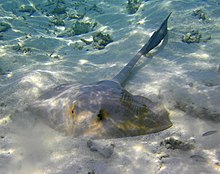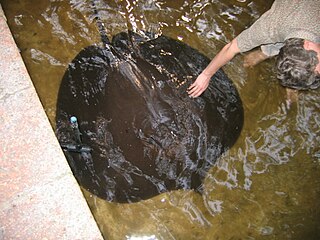
The giant freshwater stingray is a species of stingray in the family Dasyatidae. It is found in large rivers and estuaries in Southeast Asia and Borneo, though historically it may have been more widely distributed in South and Southeast Asia. The largest freshwater fish and the largest stingray in the world, this species grows up to 2.2 m (7.2 ft) across and can reach up to 300 kg (660 lb) in weight. It has a relatively thin, oval pectoral fin disc that is widest anteriorly, and a sharply pointed snout with a protruding tip. Its tail is thin and whip-like, and lacks fin folds. This species is uniformly grayish brown above and white below; the underside of the pectoral and pelvic fins bear distinctive wide, dark bands on their posterior margins.

Himantura is a genus of stingray in the family Dasyatidae that is native to the Indo-Pacific. In a 2016 taxonomic revision, many of the species formerly assigned to Himantura were reassigned to other genera.
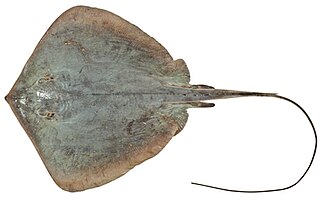
The estuary stingray, also called the estuary stingaree or brown stingray, is a species of stingray in the family Dasyatidae. Endemic to eastern Australia, it typically inhabits shallow, mangrove-lined tidal rivers, estuaries, and bays in southern Queensland and New South Wales. This yellow-brown to olive ray grows to at least 93 cm (37 in) across. It has a diamond-shaped pectoral fin disc and a mostly smooth, whip-like tail bearing both dorsal and ventral fin folds. It can additionally be identified by its long, narrow nostrils and the row of thorns along the midline of its back.

The Ganges whip ray is an obscure species of stingray in the family Dasyatidae, apparently endemic to the Ganges River system and adjacent marine waters. With an oval pectoral fin disc and long projecting snout, it closely resembles, and may be the same species as Himantura chaophraya. Growing to 1.4 m (4.6 ft) across, it is a plain dark colour above, and lighter below with wide dark bands on the lateral disc margins. The International Union for Conservation of Nature (IUCN) has listed this species as Endangered, as it faces overfishing and habitat degradation within its heavily populated range.

The marbled whipray is a little-known species of stingray in the family Dasyatidae, native to several freshwater rivers in Southeast Asia. This species has an oval pectoral fin disc with an elongated, pointed snout and a very long, whip-like tail without fin folds. It is characterized by numerous heart-shaped dermal denticles and tubercles on its upper surface, as well as a reticulated pattern of brown blotches on a light background. The maximum recorded disc width is 36 cm (14 in). The marbled whipray has been assessed as Endangered by the International Union for Conservation of Nature (IUCN); it is heavily threatened by fishing and habitat loss, degradation, and fragmentation.
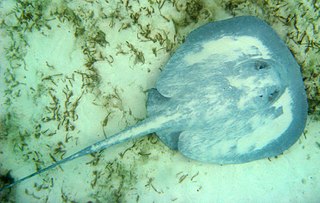
The chupare stingray or Caribbean whiptail stingray is a species of stingray in the family Potamotrygonidae, found in the western Atlantic Ocean from the Gulf of Campeche to Brazil, including the Antilles. The presence of this species in the Gulf of Mexico has not been confirmed. It also occurs in the Bahamas. It usually inhabits sandy substrates, sometimes near coral reefs, and is an infrequent visitor to the Amazon River estuary. Leonard Compagno doubted the taxonomic validity of this species in his 1999 Checklist of Living Elasmobranchs.
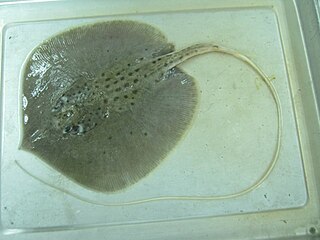
The white-edge freshwater whipray is an extremely rare species of stingray in the family Dasyatidae, native to four river systems in Southeast Asia. Measuring up to 60 cm (24 in) across, this ray has an oval pectoral fin disc and a very long, whip-like tail without fin folds. It can be identified by the presence of a sharply delineated white band running around the margin of its otherwise brown disc, as well as by its white tail and a band of dermal denticles along the middle of its back. This species feeds on benthic invertebrates and is aplacental viviparous. Its two long tail spines are potentially dangerous to humans. The International Union for Conservation of Nature (IUCN) has assessed the white-edge freshwater whipray as Endangered, as it is under heavy pressure from fishing and habitat loss, degradation, and fragmentation.

The whiptail stingrays are a family, the Dasyatidae, of rays in the order Myliobatiformes. They are found worldwide in tropical to temperate marine waters, and a number of species have also penetrated into fresh water in Africa, Asia, and Australia. Members of this family have flattened pectoral fin discs that range from oval to diamond-like in shape. Their common name comes from their whip-like tails, which are much longer than the disc and lack dorsal and caudal fins. All whiptail stingrays, except the porcupine ray, have one or more venomous stings near the base of the tail, which is used in defense. In order to sting their victims, they jerk their tails as the stinger falls off and stays in the wound that they have created. The stinger of a whiptail stingray is pointy, sharp with jagged edges. They range in size from 0.18 to 2.0 m or more across in the case of the smalleye stingray and giant freshwater stingray.

Pastinachus is a genus of stingrays in the family Dasyatidae. This genus was long held to be monotypic, containing only the cowtail stingray. Recent studies of Indo-Pacific stingrays have revealed that there are in fact a number of different species of Pastinachus, and that some former junior synonyms may need to be resurrected.

The mangrove whipray or whitetail stingray, is a species of stingray in the family Dasyatidae. It is widely distributed in the Indo-Pacific region from the Red Sea to northern Australia and Micronesia. A benthic inhabitant of shallow inshore waters, juvenile mangrove whiprays favor mangrove and estuarine habitats, while adults favor sandy to rocky areas in lagoons and coral reefs. This species can be identified by its thick, oval pectoral fin disc that is dark gray above with numerous white flecks, and by its relatively short, whip-like tail that is white past the stinging spine. It grows up to 1.4 m (4.6 ft) across.

The reticulate whipray or honeycomb stingray is a species of stingray in the family Dasyatidae. It inhabits coastal waters in the western Indian Ocean including the Red Sea, Natal and the Arabian Sea; also a Lessepsian transmigrant in the eastern Mediterranean. A large species reaching 2 m (6.6 ft) in width, the reticulate whipray has a diamond-shaped pectoral fin disc and an extremely long tail without fin folds. Both its common and scientific names refer to its ornate dorsal color pattern of many small, close-set dark spots or reticulations on a lighter background. However, the reticulate whipray is only one of several large spotted stingrays in the Indo-Pacific which, coupled with the variability of its coloration with age and locality, has resulted in a great deal of taxonomic confusion.

The pink whipray is a species of stingray in the family Dasyatidae, with a wide but ill-defined distribution in the tropical Indo-Pacific from southern Africa to Polynesia. It is a bottom dweller that generally inhabits shallow water under 70 m (230 ft) deep, in sandy areas associated with coral reefs. Individuals exhibit a high degree of fidelity to particular locations. The pink whipray has a diamond-shaped pectoral fin disc wider than long, with a broad-angled snout and a very long, whip-like tail without fin folds. It has only a few small thorns on its back and is uniform brownish to grayish pink in color, becoming much darker past the tail sting. This large ray can reach 1.8 m (5.9 ft) across and over 5 m (16 ft) long.

The Jenkins' whipray is a species of stingray in the family Dasyatidae, with a wide distribution in the Indo-Pacific region from South Africa to the Malay Archipelago to northern Australia. This large species grows to 1.5 m (4.9 ft) across and has a broad, diamond-shaped pectoral fin disc and a whip-like tail without fin folds. It has a band of heart-shaped dermal denticles running from between the eyes to the tail on its upper surface, along with a characteristic row of large spear-like thorns along the midline. It is uniform yellowish brown above, becoming grayish on the tail past the stinging spine, and white below; there is apparently a spotted color variant that had previously been described as a different species, the dragon stingray.
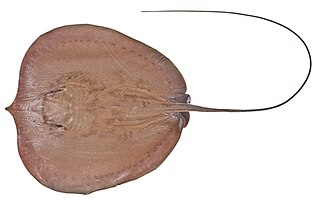
The freshwater whipray is a little-known species of stingray in the family Dasyatidae, found in a number of large rivers and associated estuaries in northern Australia. Until recently, this species was regarded as a regional subpopulation of the similar-looking but much larger giant freshwater stingray of Southeast Asia. Typically reaching 1 m (3.3 ft) across, the freshwater whipray has a distinctively shaped, rounded pectoral fin disc, a projecting snout, and a thin tail without fin folds. It is plain brown above and white below with dark marginal bands. It may occasionally travel onto land and can "breathe" out of water for up to 7 minutes. The freshwater whipray is an active hunter of small fishes and shrimps, and does not currently face substantial conservation threats.
The Hortle's whipray is a little-known species of stingray in the family Dasyatidae, occurring in shallow estuaries and mud flats off southern New Guinea. This species, growing to 71 cm (28 in) across, has a heart-shaped pectoral fin disc with a long, pointed snout and minute eyes. It has a wide dorsal band of dermal denticles extending from in front of the eyes to the tail, as well as scattered sharp denticles on the snout. The underside of the disc is a distinctive bright yellow in color, sometimes with darker markings around the nostrils, mouth, and gill slits. The Hortle's whipray is threatened by extensive seine fisheries and habitat degradation, leading the International Union for Conservation of Nature (IUCN) to assess it as Near Threatened.
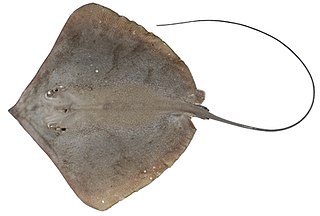
The brown whipray is a species of stingray in the family Dasyatidae, common in inshore, muddy habitats along the northern coast of Australia. It has often been confused in literature for the honeycomb stingray and the black-spotted whipray, which until recently was thought to be the same species. This species has an angular, diamond-shaped pectoral fin disc and a long, very thin tail without fin folds. It is plain brown above, sometimes with white dots or flecks near the edge of the disc, and white below; the tail is dark all over, with alternating dark and light bands near the tip. The maximum recorded disc width is 74 cm (29 in).

The blackedge whipray is a little-known species of stingray in the family Dasyatidae, found in the coastal waters of the Bay of Bengal and the Gulf of Mannar. Attaining a disc width of 1.8 m (5.9 ft), this species has a diamond-shaped disc with two small concavities on either side of the snout tip, and a long, whip-like tail without tail folds. It is characterized by large thorns with star-shaped bases scattered over the disc, and by the wide, black marginal bands on the underside of the disc. The International Union for Conservation of Nature (IUCN) currently lacks sufficient data to assess the blackedge whipray beyond Data Deficient.

The leopard whipray is a little-known species of stingray in the family Dasyatidae, found in the Indian and Pacific Oceans from the Andaman Sea to the Coral Triangle. It is found close to shore at depths shallower than 70 m (230 ft), over soft substrates. Attaining a width of 1.8 m (5.9 ft), this species has a diamond-shaped pectoral fin disc with a pointed snout and an extremely long, whip-like tail without fin folds. Adult rays have a leopard-like dorsal pattern of dark brown rings on a yellowish brown background, as well as a row of enlarged, heart-shaped dermal denticles along the midline of the disc. Newborns and small juveniles have large, solid dark spots and few denticles. The leopard whipray is caught by fisheries in many parts of its range, primarily for meat.

The honeycomb whipray is a species of stingray in the family Dasyatidae, found widely in the shallow coastal waters of the Indo-Pacific from India to the Malay Archipelago. This large species grows to 1.3 m (4.3 ft) across and has a diamond-shaped disc with rounded corners and a projecting, pointed snout. Its tail is long and whip-like, without fin folds. Adults have a striking dorsal color pattern consisting of large, dark brown rings and reticulations delineated by thin yellow lines, while juveniles have a pattern of large dark spots. This ray can also be distinguished from its similar relatives by an enlarged, pearl-like dermal denticle at the center of the back, which is followed by a few thorns. The International Union for Conservation of Nature (IUCN) has assessed the honeycomb whipray as endangered, as it faces heavy fishing pressure and habitat degradation across much of its range.
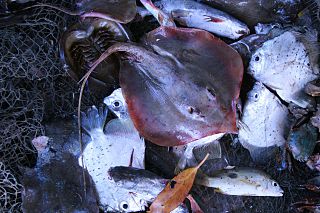
Brevitrygon walga, the dwarf whipray or mangrove whipray, is a small stingray, a cartilaginous fish in the family Dasyatidae. It is a demersal fish and is found over the continental and insular shelf of the west central Pacific Ocean where it is heavily fished. The IUCN has assessed it as being "near-threatened".



